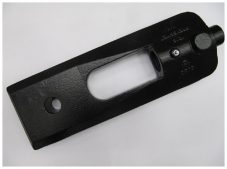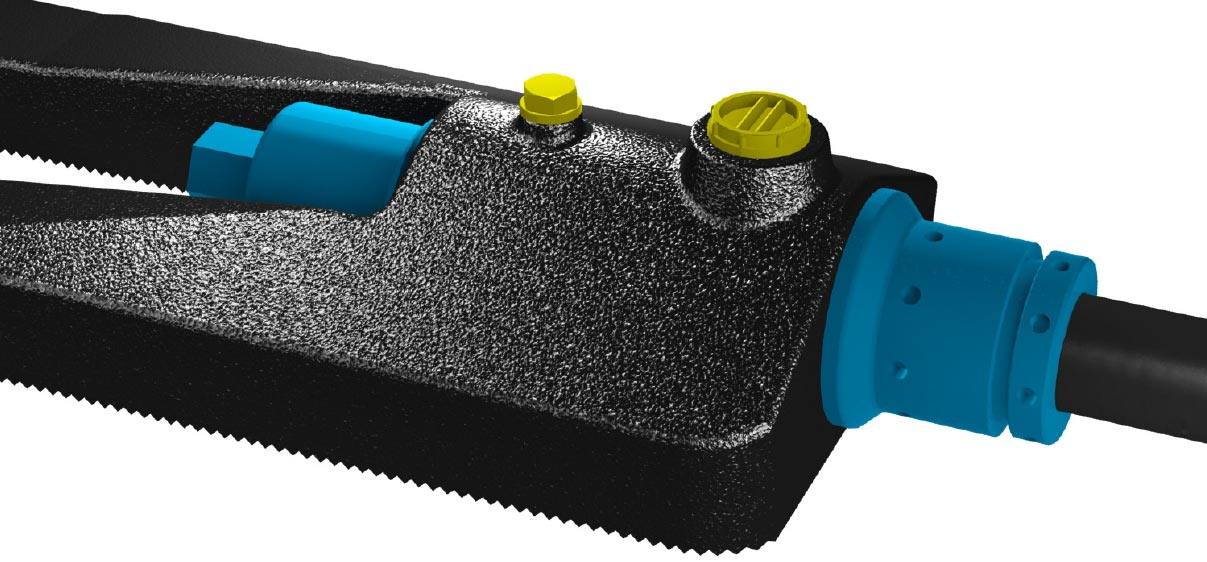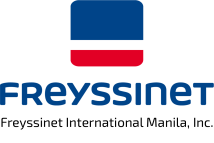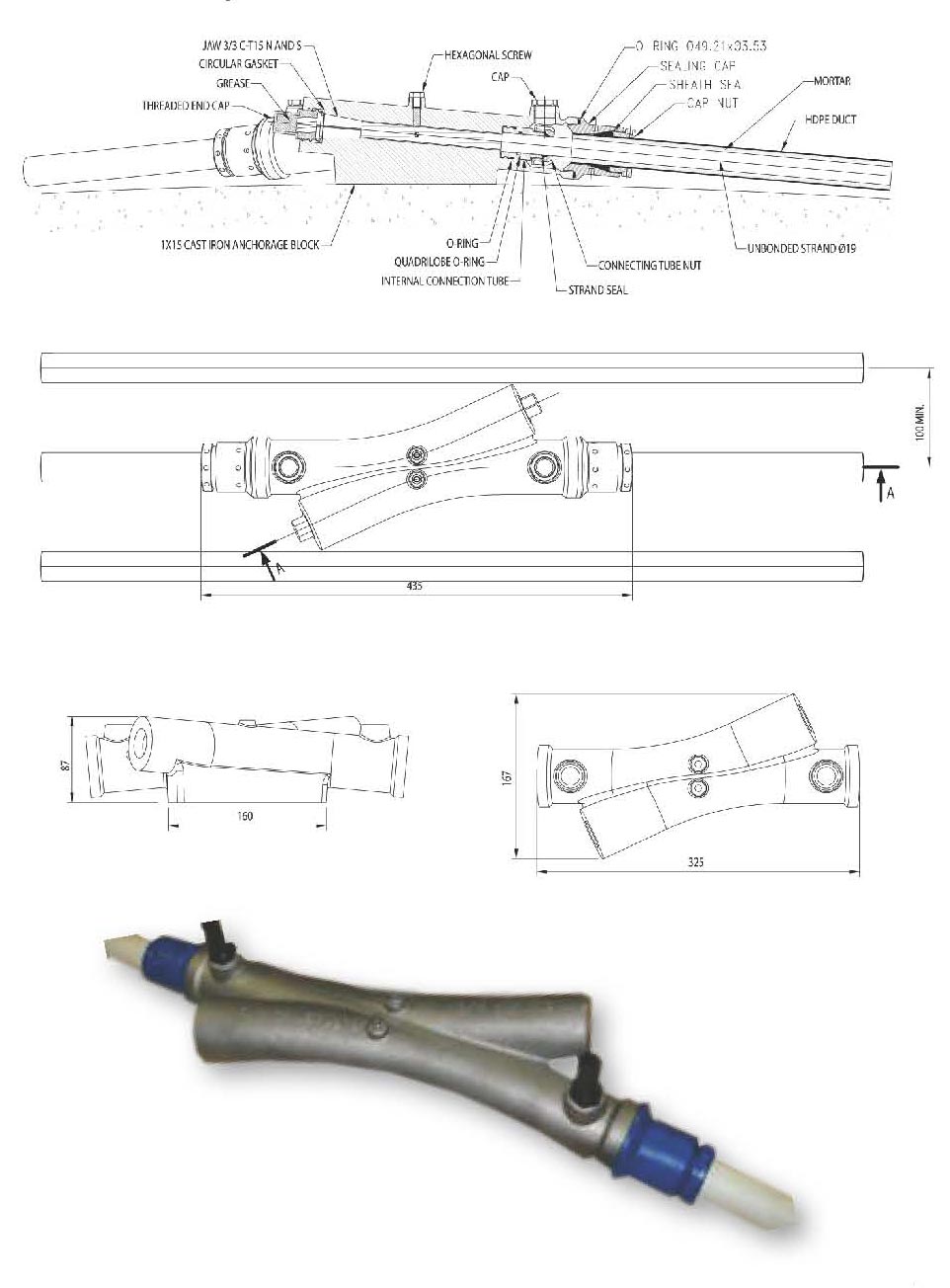1. Additional Post-Tensioning
A. 1R15 ADDITIONAL PRESTRESSING ANCHORAGE
Performance and reliability | Easy to install | Prestressing load transferred at slab edge
DESCRIPTION
The Freyssinet 1Rm15 anchorage is used to strengthen structures by additional post-tension. It anchors one strand by a barrel and 3 pieces wedge and is well suited for thin elements like slabs and webs.
The Freyssinet 1R15 anchorage is clamped against the facing support by means of a prestressed (fixing) bar which crosses or is anchored in the structure. The interface between the anchorage and the bush hammered concrete surface is covered by a layer of epoxy resin (Foreva® Epx SC980). Thus the prestressing force of the strand is transferred to the structure by friction improved by bonding (resin).
The elongated shape of the anchorage allows its positioning close to the edge of the element to be strengthen. The stressing of the strand is ensured by means of a monostrand tensioning jack equipped with a curved nose.
ADVANTAGES
Compared to traditional solutions such as concrete blisters or steel saddles, the IRIS anchorage provides multiple advantages:
- The performance and the reliability of an industrial production process anchorage (cast iron),
- Prestressing load transferred directly to the support,
- A compact solution,
- An adjustable protection level according to the requirements of the project,
- An easy and fast installation,
- No concrete or mortar to cast on site,
- A tensioning method using a single monostrand jack,
Longitudinal Prestressing:
| Prestressing reinforcement: | 15.7mm / 1860 MPa strand (standard NFA 35-045 or pr EN 10138) |
| Prestressing load: | 80% x 279 kN max. |
| Strand protection: | 5 available options (details on next page) |
Active anchorage:
 |
|
| Anchorage size: | 725 (L) x 150(l) x 78 (h) mm |
| Mass: | 22 kg |
| 3-wedge anchorage system in a single strand pot anchorage (barrel). | |
Passive anchorage:
 |
|
| Anchorage size: | 470 (L) x 150(l) x 78 (h) mm |
| Mass: | 16.4 kg |
| 3-wedge anchorage system in a single strand pot anchorage | |
Connection to the structure (fixation):
| Prestressing bar: | FREYSSIBAR®, Ø 26.5mm, 1030 MPa (standard prEN 10138) |
| Bar tensioning force: | 415 kN |
| Minimum fixing bar force: | 248 kN min after losses (instantaneous and differed) |
| Interface resin: | Foreva® EPX SC 980 or equivalent |
| Concrete compressive strength: | 20 MPa min on cylinder |
PERFORMANCE
The 1R15 anchorage and its fitting have been tested in order to ensure the realiability and the performance for additional prestressing applications.
INSTALLATIONS
The installation is usually done according to the following sequence.
- Coring of the existing structure to allow the placing of a fixing bar
- Sandblasting/ bushing of the surface area where the anchorage will be positioned.
- Placing of the 1R15 anchorage on a bed of epoxidic resin type Foreva® EPX SC 980. Threading of the bar.
- Fixing bar stressing after hardening of the resin (48 hours).
- Protection of the prestressing bar.
- Installation of the additional prestressing strand.
- Stressing of the prestressing strand using a monostrand jack equipped with a curved nose adaptation.
- Final protection of the strand and of the anchorage.
Note: Depending on the project requirements either 2 active anchorages at both ends or 1 active and 1 passive at each end of the strand can be used.
VARIOUS PROTECTION OPTIONS
Additional unbonded prestressing solutions using the 1R15 anchorages may include different options, depending of the strand used and the project requirements as the aggressivity of the environment, the durability, etc.
- Bare strand
- Protected strand (galvanised steel)
- Greased and coated strand
- Bare strand contained in an HDPE duct injected with a soft (wax) or stiff (cement grout) product after tensioning.
- Greased and coated strand inside an HDPE duct injected with cement grout before tensioning for a triple layer protection.
The anchorage itself is fitted with the necessary accessories that ensure an efficient level of protection
for the exposed parts of the cable, it is covered by a protective coating (Rilsan type) on its external faces.

Greased and coated strand in HDPE duct option
B. 1×15 ANCHORAGE
Covered by a CE marking | In service structural strengthening | Adapted to a large range of circular structures | High corrosion protection
INTRODUCTION
Freyssinet has developed specific anchorage for the active strengthening of circular structures, the 1X15. This anchorage uses post-tensioning (PT) cab;e loops to apply pressure on the structure being repaired, is suitable for all pressure on the structure being repaired, is suitable for all circular structures including silos, tanks, chimneys, cooling towers, pipes, old brickwork, etc.
DESCRIPTION
Loops
The Loops are composed of unbonded PT strands (called monostrands ) inserted into a High-Density PolyEthylene (HDPE) general duct; the annular space in the duct is cement grouted.
The characteristics of the strands that can be used are as follows:
| Diameter | Type | Designation | Fpk |
|---|---|---|---|
| Ø 15,2 | T15 | Standard strand | 260 kN |
| Ø 15,7 | T15s | Super strand | 279 kN |
| Ø 15,2 | T15c | Compact strand | 300 kN |
The PT strands themselves are individually protected by grease and a HDPE extruded coating; the protection allows the strands to slide freely without being bonded to the structure.
Cement grout is injected into the duct before tensioning the tendon so that the monostrand is perfectly embedded and a more uniform pressure is applied on the concrete facing.
The strand itself is thus perfectly protected against corrosion by two barriers:
- the individual grease protection & HDPE shealth, to prevent the curculation of humidity,
- the HDPE outer duct, filled with cement grout.
For applications in an aggressive environment or if longer durability is requried, galvanised strands may also be used.
Finally, the loops can be protected against mechanical or thermal aggression embedding them with shotcrete.
Anchorage
The body of the anchorage is made of ductile cast iron that bears on the structure being reinforced. It performs the following functions:
- Guiding of the monostrand from the duct to the anchorage,
- Connection with the general duct and the monostrand, using HDPE parts with fitting for the cement grout injection tube,
- Cylindrical-conical holes & conical jaws (composed of three wedges) in which the strands are anchored,
- Corrosion protection of the jaws and their environment, by grease-filled HDPE caps,
- Corrosion protection inside the anchorages by injecting grease through screwed grease nipples.
Optional: In the event that the anchorage is used in an aggressive environment and not protected by shotcrete, it is possible to protect the outside of the anchorage by means of Rilsan coating.
The 1×15 anchorage is designed to achieve a single “loop” PT strand (one complete ring around the structure). Each end of the strand enters into the body anchorage with the loop curvature radius, it is then deviated inside the anchorage guiding the strand to the cylindrical-canonical orifice.
INSTALLATION
Installation of monostrand and anchorage
The usual intallation method consists of prefabricating the cables loops, the monostrands, are cut to length and then inserted into the HDPE duct. The loops are then placed onto supports that have been previously fitted around the structure.
After preparation of the anchorage using wedges. The strands are inserted through the body of the 1X15 anchorage using a special hydraulic inserting device.
After insertion, the loop must be tightened to its final position and have perfect contact with the structure.
Protection of the anchorage zones and grouting of ducts.
Anchorage zones are protected by filling the anchorage body with grease.
The next step is the cement grout injection into the annular space between the general duct and the monostrand.
Since grout quantities per loop are small, the operation can be done on several loops simultaneously.
Tensioning
When the grout has reached the relevant compressive strength, the loops are tensioned using the SC2-M23 monostrand jacks adapted to the anchorage.
Final protection of the anchorage zones
After removal of the overlengths, the remaining strands ends are protected by grease and a special HDPE cap.
Additional protection can be provided by locating the Anchorage in a pocket and filling the pocket with concrete, or embedded in a continuous rib.
PERFORMANCES
The 1×15 loop anchorge has successfully passed the static and dynamic tests specified by ETAG 013 (Guideline for European Technical Approval of PT kits.) The 1×15 anchorage is covered by the ETA 06/0226 and has a CE marking.
Diameter of the structure
The 1X15 anchorage is suitable for a range of structural diameters, the standard diameter range is between 6 & 27.5m. For cable diameters less that 13m, the 1X15 anchorage is fitted with 2 transition shims which are installed under the cable just at the exits of the anchorage.
NOTE: Other structural diameters are possible but the will require a specific case study.
2. Foreva LFC
High strength unidirectional reinforcement | Corrosion free material | Light and thin | Factory made composite controlled in geometry and strength
Foreva® LFC is the Freyssinet solution for structural strengthening by bonded composite. The solution utilizes a pultruded carbon fibre laminate bonded against the facing with an epoxy adhesive.
ADVANTAGES
- Fast loading of the strengthening: due to its high modulus of elasticity, the bonded composite immediately drains a significant fraction of the stresses introduced in the section when the strengthened structure is loaded.
- Fast installation: application directly to the concrete surface by gluing; fibre impregnation is factory made.
- No reduction in the clearance: valuable for installations such as car parks.
- No added weight.
- Fire, shock and UV resistances: can be enhanced by an optional protective cover.
FIELDS OF APPLICATION
The Foreva® LFC solution strengthens slabs under flexure, beams under bending and shear, and any elements in tension.
Foreva® LFC is suitable for standard or industrial buildings, bridges and any kind of concrete structure, subject to static loads. It can also be used on wood, metal and masonry structures.
PRINCIPLE
The Foreva® LFC solution is based on the bonding of pultruded carbon fibers laminates with a high adhesion strength epoxy resin. The laminate is factory made by pultrusion of carbon fibres impregnated by an epoxy resin.
The resulting composite becomes loaded as soon as the strengthened element begins to deflect.
Under permanent deformation of the strengthened element the durability of the resisting effort generated by the composite is ensured by its excellent resistance to creep effects.
EXPERTISE
Design rules associated with Foreva® LFC are available from the Freyssinet technical department.
PRODUCTS
The Foreva® LFC solution comprises specific resin and pultruded laminates to fabricate the strengthening composite Foreva® LFC 50/80/100 and 150.
SPECIALISED TEAMS
The Foreva® LFC solution is implemented by specialised Freyssinet teams.
If necessary, the load on the structure and cracks are injected.
Once surface integrity has been checked, the surface is prepared by mechanical scouring, and then the laminate is bonded to the facing in controlled conditions of air hygrometry and temperature.
3. Foreva TFC
High strength bi-directional reinforcement | Excellent bond strength: in place saturation | Corrosion free material | Light and thin | Certified system: technical approval from CSTB (France)
Foreva® TFC is the Freyssinet solution for structural strengthening using carbon fiber reinforced polymer. The composite is made of a carbon fiber fabric placed into an epoxy matrix, the fabric being in place saturated against the surface.
ADVANTAGES
- Fast loading of the strengthening: thanks to its high modulus of elasticity, the bonded composite immediately drains a significant fraction of the stresses introduced in the section when loading the strengthened structure.
- Easy adjustment of the strengthening cross section: strips can be overlapped, superimposed and crossed without strength reduction factor; particularly suitable for heavily stressed zones.
- Matches complex profiles and tolerates planarity defects.
- No reduction in the clearance: valuable for installations such as car parks.
- No added weight.
- Short intervention delays: fast polymerisation of the resin.
- Wide range of temperatures of use: from -20°C to 60°C in continuous service; 80°C in peak.
- Fire, shock and UV resistances: can be enhanced by an optional protective cover.
FIELDS OF APPLICATION
The Foreva® TFC solution strengthens slabs under flexure, beams under bending and shear, columns and any elements in tension. It also increases the ductility of elements, in particular those subject to accidental dynamic stresses (earthquakes).
Foreva® TFC is suitable for standard or industrial buildings, bridges and any kind of concrete structures. It can also be used on wood, metal and masonry structures.
PRINCIPLE
The Foreva® TFC solution is based on the in place fabrication of a carbon fiber composite, by saturation of the fabric with an organic resin which polymerises against the substrate, bonding the composite advantageously on the tensile stressed area of the part to be strengthener. The resulting composite is integrated to the structure and becomes loaded as soon as the strengthened element begins to deflect.
Outstanding resistance to interlamellar shear de-lamination and delamination at the composite/ concrete interface lead to a failure in the height of the concrete cover under ultimate load.
Under permanent deformation of the strengthened element the resisting effort durability is ensured by the composites excellent resistance to creep effects.
EXPERTISE
Design rules associated with Foreva® TFC are available from the Freyssinet technical department.
PRODUCTS
The Foreva® TFC solution utilizes specific resin and fabric to manufacture the strengthening composite Foreva® TFC 75, 150, 200 or 300.
Foreva® TFC anchors and braids allow the strengthening composite to be anchored to the substrate, where requried.
SPECIALISED TEAMS
The Foreva® TFC solution is implemented by specialised Freyssinet teams.
If necessary, the load on the structure is decreased and cracks are injected.
Once surface integrity has been checked, the surface is prepared by mechanical scouring, and then the composite is stratified, in place, under controlled conditions of air hygrometry and temperature.
4. Foreva Shotcrete
Excellent bond strength | High mechanical properties at young age | No risk of void behind reinforcing bars | Strong compatibility with concretes in place | Large thickness layer in one shot | Standard design rules for concrete structure is applicable to the reinforced structure.
Foreva® Shotcrete is the Freyssinet solution for repair and strengthening by dry shotcreting of concrete structures. Foreva® Shotcrete enables to obtain a perfectly bonded strengthening a
ADVANTAGES
- High performance strengthening: enable to reach C60/75 concrete strength;
- High modulus of elasticity: between 30 and 44 GPa;
- Reduced the effects of shrinkage: low water content;
- Low porosity: high compacity concrete;
- High adhesion to rebars: as good as standard concrete;
- A uniform surface with a « regular » aspect: in « grains »
- Enables long transfer distance: up to several hundreds of meters;
- User friendly: reduce cleaning operations in case of stop and restart.
FIELDS OF APPLICATION
The Foreva® Shotcrete solution enables to repair damaged facings and to strengthen elements of concrete structure.
- Appropriate for bridges, buildings and any concrete structures;
- Appropriate for underground structures, in particular tunnels : local repair, strengthening by a concrete liner connected to the ground or by an unbounded liner (support and protection of watertightness membrane );
- Suits masonry structures : strengthening of counter-vout;
- Allow to calculate the strengthened element in compliance with BAEL 91 requirements;
- Must be applied on non brittle facings with a minimum clearance of 1.5m.
PRINCIPLE
The Foreva® Shotcrete solution is based on the transfer of dry concrete and its spraying with introduction of water at the lance.
The transfer of the concrete as a dry mix between the inlet and the outlet of the pipe enables to transport it over long distances.
Dry shotcreting is characterized by:
- a high cement content in the vicinity of the interface with the facing due to the rebond of the biggest aggregates;
- a compacting effect in the thickness of the layer applied by the aggregates which are spayed against the facing at very high speed.
Consequently the shotcrete has an excellent bond strength to the substrate and high mechanical properties, without risk of void behind rebars.
EXPERTISE
Freyssinet technical department determines the concrete mix formula, the equipment (capacity, flow rate, etc.) and the procedure of application (thickness to be sprayed, number of layers, delays between layers, etc .) in relation to the specificities of the works (distance of transfer, concrete strength, etc.).
PRODUCTS
Concrete mix formula is designed by Freyssinet technical department who determine the type and fraction of components: cement, sand, aggregates, admixtures, fibres and additions, so as to reach the required performances.
Admixtures:
- maintain fluidity (stabilize the setting);
- initial cohesion (activators);
- stiffening (accelerate the start of setting).
Fibres:
- better cohesion of fresh concrete;
- reduce the effects of shrinkage;
- increase mechanical properties.
Additions:
- higher bonding properties (fumee de silice).
The concrete is either a ready for use concrete or a premixed concrete (in bags, in big bags or in a tank), or fabricated on site.
SPECIALIZED TEAMS
The Foreva® Shotcrete solution is implemented exclusively by Freyssinet teams who defines in particular the substrate preparation procedure, the spraying equipment, the arrangement at the working areas and the provisions for noise, vibrations, dust and pollution.
Freyssinet specialists in shotcreting are certified by ASQUAPRO.



